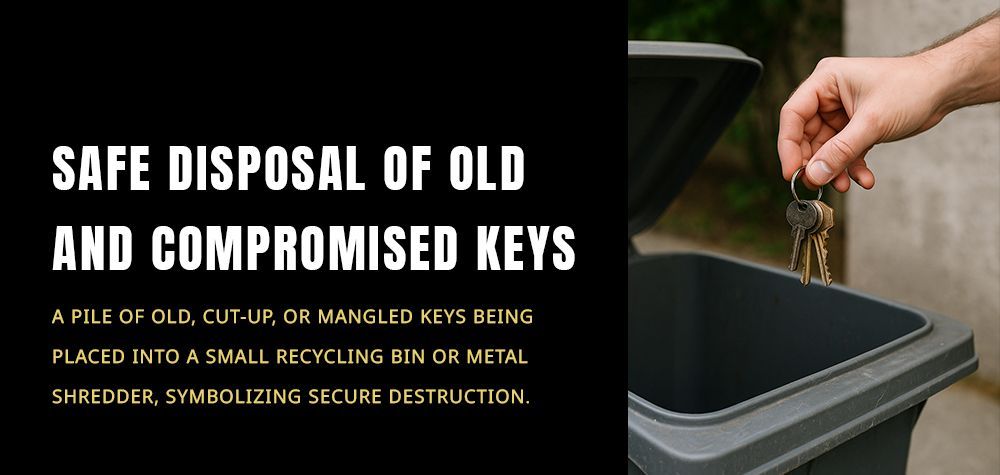How Often Should You Lubricate Your Locks?
When was the last time you thought about lubricating your locks?
If you’re like most people, the answer is probably “never” — until the key gets stuck, the lock feels stiff, or the door won’t budge on a rainy morning.
But here’s the thing: just like your car, hinges, or tools, your locks need maintenance too. And one of the simplest, most effective ways to keep them working smoothly is regular lubrication.
In this guide, we’ll answer how often you should lubricate your locks, why it matters, what type of lubricant to use, and how to do it the right way — so you can prevent costly lockouts and extend the life of your locks.
"How Weather Affects Your Locks and What to Do About It"
Why Do Locks Need Lubrication in the First Place?
Locks might look solid and simple on the outside, but inside, they’re made of delicate mechanical components: tiny springs, pins, cylinders, and levers. Every time you turn a key, these parts rub against each other.
- Without proper lubrication, this friction causes:
- Wear and tear on internal mechanisms
- Sticking, jamming, or difficulty turning the key
- Rust and corrosion (especially in humid or rainy climates)
- Lock failure over time
Regular lubrication reduces friction, protects against dirt and moisture, and ensures the lock functions smoothly — all year round.
So, How Often Should You Lubricate Your Locks?
The general rule of thumb is:
Lubricate your locks at least once every 6 months.
However, the ideal frequency depends on the environment, the type of lock, and how often it's used.
- High-Use Locks (e.g. front door, commercial entrances):
Every 3 to 6 months
These locks experience daily use and are exposed to the elements — meaning more wear and a higher risk of grime buildup.
- Outdoor Locks (e.g. gates, sheds, padlocks):
Every 2 to 3 months
Outdoor locks are more vulnerable to rain, dust, and temperature swings. Regular maintenance helps prevent rust and internal damage.
- Interior Locks (e.g. bedroom, office doors):
Once a year is usually enough
If they’re not exposed to the outdoors or frequent moisture, interior locks don’t need much upkeep — but don’t ignore them completely.
- Vehicle Locks:
Every 6 months, or more often in cold weather
Car door and ignition locks can freeze or wear down quickly if neglected, especially during winter months.
Signs Your Lock Needs Lubrication — Right Now
If you’re not sure whether your lock needs attention, watch for these warning signs:
- The key is hard to insert or remove
- You have to jiggle the key to turn the lock
- The lock feels “gritty” or scratchy when turning
- It makes unusual clicking or grinding sounds
- The lock is visibly rusty or dusty
These are early indicators that friction and buildup are affecting your lock’s performance — and that it’s time to act before the lock fails entirely.
"How to Avoid Getting Locked Out Again: Expert Prevention Tips"
The Best Lubricants for Locks (And What to Avoid)
Not all lubricants are created equal — and using the wrong one can do more harm than good.
Best Lock Lubricants:
Graphite Powder: A dry lubricant ideal for indoor locks. It doesn’t attract dust and provides smooth movement.
Silicone-Based Lubricants: Great for both indoor and outdoor locks. They resist moisture and won’t gum up over time.
Teflon (PTFE) Sprays: Excellent for long-lasting lubrication, even in extreme temperatures.
Avoid These:
WD-40: It may work temporarily, but it attracts dust and turns gummy over time, causing clogs inside your lock.
Oils or Grease: These thicken, collect debris, and can trap moisture — leading to corrosion or sticky locks.
If in doubt, ask your local locksmith for product recommendations based on your climate and lock type.
How to Lubricate Your Lock (Step-by-Step)
Step 1: Clean the Lock First
Use a soft cloth to wipe off any visible dirt or debris around the keyhole. For outdoor locks, consider spraying compressed air to remove dust inside the cylinder.
Step 2: Apply the Lubricant
For sprays: Insert the nozzle into the keyhole and give it a short, controlled spray (2-3 seconds).
For graphite powder: Squeeze a small puff into the keyhole.
Step 3: Insert and Turn the Key
Insert your key and turn it back and forth several times to spread the lubricant evenly. Wipe off any excess that comes out with the key.
Step 4: Test the Lock
Make sure the lock now turns smoothly without resistance. If it still feels stiff, repeat the process or call a locksmith for further inspection.
Lock Lubrication Through the Seasons
Weather affects how often you should lubricate:
Winter: Ice and condensation can freeze internal parts. Use PTFE or silicone lubricants that won’t harden in cold.
Summer: Heat can cause expansion and stickiness, especially in metal locks. Lubricate to reduce friction.
Rainy/Humid Months: Moisture invites rust. Clean and lubricate often to protect exposed locks.
Seasonal maintenance helps your locks stay weather-resistant and reliable.
What Happens If You Never Lubricate Your Locks?
If left unchecked, dry and dirty locks may eventually:
- Jam or seize completely
- Break your key inside the cylinder
- Require expensive repairs or full replacements
- Leave you locked out when you least expect it
In short — you’ll spend far more later than you would by doing simple preventive maintenance now.
When to Call a Locksmith Instead
If your lock is:
- Still sticking after lubrication
- Making grinding noises
- Showing signs of internal damage or broken parts
- Already caused a key to break inside
…it’s time to bring in a professional. A locksmith can clean, disassemble, rekey, or replace the lock as needed — and may recommend weather-resistant upgrades if your climate is especially harsh.
Conclusion:
Lubricating your locks might not seem urgent, but it’s one of the easiest ways to protect your property, prevent breakdowns, and extend the life of your security system.
Do it at least twice a year — or more often for outdoor and high-use locks — using the right lubricant and a few simple steps. Your locks will thank you with smooth operation, fewer headaches, and better peace of mind.
And if you’re unsure, don’t hesitate to contact a professional locksmith for help. After all, maintenance today is a lot cheaper than an emergency callout tomorrow.
Call Us Any Time!








